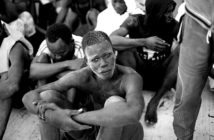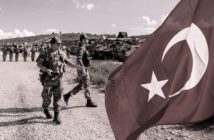As the Syrian regime’s elite Tiger forces, Hezbollah fighters and National Defence Force (NDF) militias have advance and capture Deir ez-Zor city from the IS, the mainly Kurdish Syrian Democratic Forces (SDF) have launched an attack on the other side of the Euphrates river to capture the entire eastern shore from Daesh.
The Syrian Democratic Forces (SDF) supported by the American-led coalition already shares a border with the regime further to the east of Deir ez-Zor and are co-opting in other areas, for example in Hasakah governorate. There, two regime controlled enclaves exist along with an important military airfield in Qamishli city. Regime and Kurdish schools are running side by side; government institutions continue their work and they trade oil and agricultural products between each other. This is a well-established affair within a region where the Kurdish Democratic Union Party (PYD) and its armed wing, the YPG are asserting control. Their recent education reform made Kurdish language a mandatory subject in all schools, which sparkled protest inside their territory. Moreover, forced conscription within the YPG had sparked protests in the souq of the predominately Sunni town of Manbij.
The mainly Kurdish SDF is also making military advances deep inside former IS-held, predominately Arab territories, with American support. Their goal was to eliminate the Islamic State from the whole of the East Bank of the Euphrates river until Abu Kamal which lies at the Iraqi border. The race has started even before the “liberation” of Raqqa by the SDF and Deir-ez Zor city by the Syrian regime. There’s however another player in the equation: The Shiite Paramilitary Units (PMU) in Iraq. Moreover, the Iraqi Armed Forces themselves are also keen to secure more territory and have sided with the Assad government; both have allowed each other’s air-forces to carry out raids within their respective territories. Late October and early November, the cooperation between Iraq and Syria reached a new level. Regime forces crossed into Iraq, where they meet the Shiite PMU forces. Then, from Iraq, a successful ground offensive was launched which led to Abu Kamal: the SDF was too late. As Daesh reaches its end in Syria, the left-overs pieces are at stake.
The battle for Deir ez-Zor province
The moment when the regime-allied forces broke the siege of Deir ez-Zor in early September, the SDF launched a surprise attack on the other side of the Euphrates river which divides the city. It can be questioned that if the SDF had enough resources to attack towards Deir ez-Zor which has been encircled by the Islamic State for three years, why didn’t they start the offensive to help the people suffering under IS rule before the regime did?
The dynamic in Eastern Syria points towards the SDF with Western artillery and air support will push IS out and take control of most the eastern side of Euphrates, leaving the regime to deal with the western side, which is Deir ez-Zor’s province more populated.
Nevertheless, both the SDF and the regime leaders have decided to add fuel to the fire. In March, SDF forces crossed the Euphrates river in order to expel IS forces near Tabqa city and dam. They advanced even deeper into the south-western shore, ultimately reaching regime front lines and stopping there. As a response, the regime crossed the river during the Deir ez-Zor offensive late September using a makeshift Russian bridge as all of the city’s bridges have been destroyed by airstrikes previously. This means that the two warmongers are active in territories across the river, with no regards to the discursive threats coming from both of them, regarding its crossing.
The Islamic State hasn’t been quiet either. Although they didn’t manage to capture Deir ez-Zor city after more than 3 years of siege and ultimately the regime reached their trapped troops and citizens, they’ve once again shown that they are a formidable force in desert offensives. Occupying villages and hills makes them an easy target for airstrikes and advanced artillery which explains the regime’s quick 200km advance from Palmyra to Deir ez-Zor. However, holding several hundreds of kilometres of frontline is difficult against fast-moving camouflage IS vehicles and suicide bombers which blend well into the arid land.
A Daesh counter-offensive during the beginning of October managed to cut the road leading from Palmyra to Deir ez-Zor which was a clear blow to the regime (although the city could still be reached from the North-West along the Euphrates river). The Islamic State also managed to capture and hold the strategic town of al-Suknah for several days, encircling and trapping dozens of badly equipped Assad allied NDF soldiers and two Russian mercenaries (who they interviewed on camera before reportedly executing them).
IS forces are active deep inside regime territory as well. They set up random checkpoints dressing up as Syrian army soldiers on the road leading to Deir ez-Zor as they currently are able to infiltrate through the desert without being spotted. Their sleeper cells were also woken up in the town of al-Qaryatayn in October, which the government deemed so safe that after one year of control, they let refugees from Jordan return to their homes this August. Weeks after, IS attacked. Their goal is clearly to stretch the government forces thin and disrupt the current offensive which was launched from Palmyra through Deir-ez Zor to reach Abu Kamal at the Iraqi border before the SDF does.
All signs point to the partition of Syria, or at least to an autonomy for the Kurds. The long-time Syrian Foreign Minister, Walid al-Moualem hinted at just that in a recent interview: “This topic is open to negotiation and discussion and when we are done eliminating Daesh, we can sit with our Kurdish sons and reach an understanding on a formula for the future”. He was candid by using the word “Kurdish sons” as Assad still sees them as a part of the Syrian Arab Republic whose ultimate goal is to reconquer the whole of Syria. A separate Kurdish state is unlikely, but the flags of both the YPG and Syria could fly next to each other in certain areas. Neither has Mazlum Kobane, the chief commander of the Syrian Democratic Forces, ruled out living side by side with the regime.
Now that the final major Islamic State stronghold has fallen in Syria i.e. Deir ez-Zor, desert and smaller towns and villages remain, which await the disappearance of long-term IS control while the latter adapts to guerrilla warfare. We have seen a case of it in al-Qaryatayn.
Superiority in the air has been the key factor in advancing through scarcely inhabited zones. However, keeping control and providing safety will remain a big challenge for the Assad government in the mid-term.
Who will get the biggest slice?
The remaining IS areas are being taken over by the regime and the Kurds who haven’t shown any willingness thus far in fighting each other. As both players have powerful allies in the US and Russia respectively, it seems unlikely that they will point their weapons against each other in the near future.
But what will happen with the tribes which forged alliances and pledged “baya” to IS? When the Islamic State took over the province in 2014 some tribes or “Ansar” in IS terminology joined them to gain power. Others decided to remain and fight with the regime and many had to flee the region. Between 700-900 members of the al-Shaitat tribe were executed by the Islamic State. Revenge between tribes is likely once the fighting against the Islamic State is over in Syria’s east. Manipulating and turning tribes against each other have been both regime and IS speciality in the past. Once again, some will have to flee (but where?) while others can loot and gain influence if they’re lucky.
It seems unlikely that Western style democracy with fair elections will grow out of this mess. Instead, brute force, shaky diplomacy and some chaos will prevail for the time being.





